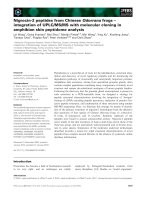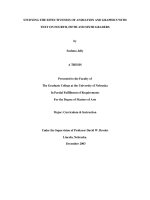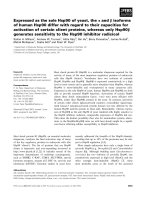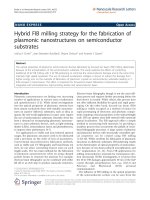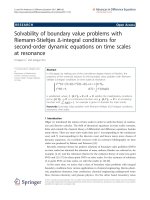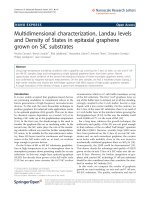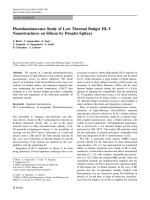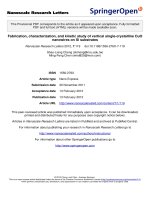Integration of indium gallium nitride with nanostructures on silicon substrates for potential photovoltaic applications
Bạn đang xem bản rút gọn của tài liệu. Xem và tải ngay bản đầy đủ của tài liệu tại đây (8.42 MB, 260 trang )
INTEGRATION OF INDIUM GALLIUM NITRIDE
WITH NANOSTRUCTURES ON
SILICON SUBSTRATES FOR POTENTIAL
PHOTOVOLTAIC APPLICATIONS
HO JIAN WEI
NATIONAL UNIVERSITY OF SINGAPORE
2014
INTEGRATION OF INDIUM GALLIUM NITRIDE
WITH NANOSTRUCTURES ON
SILICON SUBSTRATES FOR POTENTIAL
PHOTOVOLTAIC APPLICATIONS
HO JIAN WEI
(B.Eng.(1
st
Hons), NUS)
A THESIS SUBMITTED
FOR THE DEGREE OF DOCTOR OF PHILOSOPHY
NUS GRADUATE SCHOOL FOR INTEGRATIVE
SCIENCES AND ENGINEERING
NATIONAL UNIVERSITY OF SINGAPORE
2014
ACKNOWLEDGEMENTS
There are many people who have given me invaluable aid in the course of my Ph.D.
journey and made this much more palatable. I would like to take this opportunity to
express my sincerest gratitude to them. First, I would like to thank my supervisors,
Professor Chua Soo-Jin and Professor Andrew Tay, for their guidance,
encouragement and support which were instrumental in making this work possible. I
have gained much from the fruitful discussions I had with them, not only within the
realms of my research work, but also in terms of personal development. They have
provided many opportunities in enhancing both the depth and breadth of my research.
I also greatly appreciate the help from the other members of my Thesis Advisory
Committee (TAC). Professor Choi Wee Kiong, who is the TAC Chairman, has
provided a much needed perspective and played a significant role in steering my
research direction. I am truly humbled by his attitude towards life. Dr Zang Keyan
has imparted valuable knowledge on MOCVD to me, supported my research and
shared her experience in navigating research life. Dr Liu Hong Fei has inspired me
greatly in my work. His dedication to research and academic finesse is admirable. I
benefitted greatly from the many technical discussions I had with him.
Next, I would like to thank the staff at the Center of Optoelectronics (COE) in NUS,
namely, Ms Musni Bte Hussain and Mr Tan Beng Hwee, for their help in
administrative matters. I also greatly appreciate the friendship and support of my
fellow students in COE. Special mention goes to Dr Wee Qixun who has mentored
me and taught me much about the growth and characterization of III-nitrides.
iii
I am grateful for the opportunity to perform part of my research work at the Institute
of Materials Research and Engineering (IMRE), A*STAR and would like to thank
many of the IMRE staff who have helped me in the training and operation of
equipment there. This includes Mr Jarrett Dumond, Dr Tanu Suryadi Kustandi, Dr
Liu Hong, Ms Tan Hui Ru, Ms Teo Siew Lang, Ms Doreen Lai, Mr Lim Poh Chong
and Mr Eric Tang. I am also indebted to my ex-colleagues and ex-laboratory mates at
Lab 10 who have provided much needed support in the course of my work.
In addition, I would also like to acknowledge the help from the Singapore-MIT
Alliance of Research and Technology (SMART) for providing me temporary access
to its high-resolution X-ray diffraction (HR-XRD) equipment. I would like to thank
Dr Abdul Kadir and Dr Kohen David Alexandre for operation and meaningful
discussions of the machine. Next, I would like to thank Dr Michael Heuken from
AIXTRON SE for providing me substrates for MOCVD growth.
I am immensely grateful to the NUS Graduate School for Integrative Sciences and
Engineering (NGS) for providing me with a Scholarship and support for this Ph.D.
work. NGS and her staff have been extremely helpful in ensuring the well-being of
students. I truly appreciate their support.
Last but not least, I would like to thank my family, fiancée and friends for their love,
unwavering support and understanding while I was both physically and/or mentally
absent during my Ph.D. journey.
iv
TABLE OF CONTENTS
DECLARATION i
ACKNOWLEDGEMENTS ii
TABLE OF CONTENTS iv
SUMMARY ix
LIST OF TABLES xi
LIST OF FIGURES xii
LIST OF SYMBOLS xxiii
Chapter 1 Introduction 1
1.1. Current Status of Photovoltaics (PV) for Solar Energy Harvesting 1
1.2. Motivation for Integration of InGaN with Nanostructures on Si in PV 3
1.2.1. Advantages of InGaN for PV Applications 3
1.2.2. Merits of Si as a Growth Substrate for InGaN PV Applications 5
1.2.3. Potential and Technical Barriers of InGaN Solar Cells 8
1.2.4. Relevance of Nanostructuring and its Benefits 10
1.2.4.1. Nano Selective Area Growth (Nano-SAG or Scheme A) 11
1.2.4.2. Nanoheteroepitaxy on Nanopillar Substrates (Scheme B) 12
1.2.4.3. Benefits of Nanostructures 13
1.2.4.4. Plausible InGaN/Si Tandem PV Device Structures 19
1.3. Scope and Thesis Organization 23
Chapter 2 Background and Review of InGaN Growth 25
2.1. Introduction 25
2.2. Structure and Characteristics of Group III-Nitrides 25
2.3. Challenges in InGaN Growth and their Conventional Mitigation 30
2.3.1. Gallium Meltback Etching and Unintentional Nitridation of Silicon 30
2.3.2. Thermal Expansion and Lattice Mismatch 31
2.3.3. Composition Inhomogeneity and Phase Separation 34
2.3.4. Temperature Tradeoff Between Good Structural Quality and High
Indium Content 36
2.4. Novel Growth Strategies 39
v
2.4.1. Development of New Growth Methods 39
2.4.2. In-situ Silicon Nitride Masking 40
2.4.3. Selective Area Growth 41
2.4.4. Epitaxial Lateral Overgrowth (ELO) 44
2.4.5. Nanostructured Growth 45
2.4.5.1. Non-templated Nanostructure Growth 46
2.4.5.2. Templated Nanostructure Growth 49
2.4.5.2.1. Nano Selective Area Growth (Nano-SAG or Scheme A) 49
2.4.5.2.2. Nanoheteroepitaxy on Nanopillar Substrates (Scheme B) 53
2.5. Chapter Summary 55
Chapter 3 Experimental Methods: Patterning, Growth & Characterization 57
3.1. Introduction 57
3.2. Nanoimprint Lithography 57
3.2.1. Background 57
3.2.2. Step and Flash
TM
Imprint Lithography (S-FIL
TM
) 58
3.3. Metalorganic Chemical Vapour Deposition (MOCVD) 60
3.3.1. Background 60
3.3.2. EMCORE/Veeco D125 MOCVD System 61
3.3.3. Thermodynamics Consideration 66
3.3.4. Kinetics Considerations 67
3.3.5. Hydrodynamics and Mass Transport 68
3.4. Characterization Techniques 69
3.4.1. Scanning Electron Microscopy (SEM) 69
3.4.2. Atomic Force Microscopy (AFM) 72
3.4.3. Transmission Electron Microscopy (TEM) 74
3.4.4. X-ray Diffraction (XRD) 77
3.4.5. Photoluminescence (PL) Spectroscopy 83
3.4.6. Reflectance Spectroscopy 86
3.5. Chapter Summary 88
Chapter 4 Nanopatterning Techniques on Si Substrates 89
vi
4.1. Introduction 89
4.2. Fabrication of Nano-SAG Masks on Si Substrates (Scheme A) 89
4.2.1. Challenges to Uniform and Deep Pattern Transfer in S-FIL 90
4.2.2. Uniform and Deeper Pattern Transfer in S-FIL using an Angled
Deposited Metal Mask 92
4.2.3. High Aspect Ratio Patterning using a Combinatory Approach of S-FIL
and AAO 95
4.2.4. Summary on Fabrication of Type A Templates 97
4.3. Nanopatterning of Si Substrates for Nanoheteroepitaxy (Scheme B) 97
4.3.1. Overview 97
4.3.2. High Aspect Ratio Patterning of Si Substrate by S-FIL and Metal-
Catalyzed Electroless Etching (MCEE) 98
4.3.3. Summary on Fabrication of Type B Templates 104
4.4. Chapter Summary 105
Chapter 5 Scaling InGaN Thin Films into Three-Dimensional Nanostructures on
AlN/Si(111) Substrates 106
5.1. Introduction 106
5.2. Growth of InGaN Films on AlN/Si(111) Substrates 106
5.2.1. Experimental Procedure 106
5.2.2. Substrate Pretreatment 108
5.2.3. Influence of Reactor Pressure 108
5.2.3.1. Composition 108
5.2.3.2. Morphology 110
5.2.4. Influence of Growth Temperature 112
5.2.4.1. Structural Characteristics and Composition 112
5.2.4.2. Morphology 116
5.2.4.3. Photoluminescence (PL) 120
5.2.5. Conclusion 121
5.3. Three-Dimensional InGaN Nanostructures on AlN/Si(111) Substrate 122
5.3.1. Experimental Procedure 122
5.3.2. Morphology 123
vii
5.3.3. Structural Characteristics 126
5.3.3.1. Cross-Sectional TEM 126
5.3.3.2. Growth Model 130
5.3.3.3. High-Resolution XRD 131
5.3.4. Photoluminescence 133
5.3.4.1. Temperature Dependent Photoluminescence 133
5.3.4.2. Arrhenius Plot 138
5.3.5. Reflectance 139
5.3.6. Discussion 141
5.3.7. Conclusion 142
5.4. Chapter Summary 143
Chapter 6 Nano Selective Area Growth of InGaN Nanostructure Arrays 144
6.1. Introduction 144
6.2. Experimental Procedures 144
6.3. Influence of Growth Temperature 145
6.3.1. Morphology 145
6.3.1.1. Size uniformity 147
6.3.1.2. Growth Rate 148
6.3.1.3. Growth Artefacts 148
6.3.2. Structural Characteristics 150
6.3.2.1. Indium Content and Phase Composition 150
6.3.2.2. Lattice Tilt and Twist 152
6.3.3. Photoluminescence 154
6.3.4. Reflectance 156
6.4. Influence of Reactor Pressure 158
6.4.1. Morphology 158
6.4.1.1. Growth Uniformity, Growth Rate and Mass Transport 158
6.4.1.2. Coalescence Behavior 161
6.4.1.3. Growth Artefacts 162
6.4.2. Structural Characteristics 164
viii
6.4.2.1. Indium Content and Phase Composition 164
6.4.2.2. Lattice Tilt and Twist 166
6.4.3. Photoluminescence 168
6.4.4. Reflectance 170
6.5. Influence of Growth Duration 172
6.5.1. Morphology 173
6.5.2. Structural Characteristics 174
6.5.2.1. Indium Content and Phase Composition 174
6.5.2.2. Lattice Tilt and Twist 175
6.5.3. Photoluminescence 177
6.5.4. Reflectance 178
6.6. Influence of Gas Flow Rate 179
6.6.1. Morphology 180
6.6.2. Structural Characteristics 183
6.6.2.1. Indium Content and Phase Composition 183
6.6.2.2. Lattice Tilt and Twist 185
6.6.3. Photoluminescence 187
6.6.4. Reflectance 190
6.7. Growth of InGaN/GaN MQW Core-Shell Nanopyramid Arrays 191
6.7.1. Experimental Procedure 191
6.7.2. Morphology 192
6.7.3. Structural Characteristics 193
6.7.4. Photoluminescence 196
6.7.5. Reflectance 197
6.8. Chapter Summary 198
Chapter 7 Conclusion and Future Work 201
7.1. Conclusion 201
7.2. Recommendations for Future Work 205
REFERENCES 207
LIST OF PUBLICATIONS 232
ix
SUMMARY
Nanostructured growth of InGaN on Si substrates targeting photovoltaic applications
was performed in this work. The technique mitigates the challenges plaguing InGaN
heteroepitaxy on Si which result in inadequate quality high In content InGaN. The
integration of InGaN with nanostructures on Si will facilitate development of
monolithic InGaN/Si tandem solar cells which combine the bandgap tunability of
InGaN and low-cost, wide availability of Si. Two growth approaches are proposed,
namely, (A) nano selective area growth (nano-SAG) of InGaN through a nanoporous
mask fabricated on Si substrate, or Scheme A, and (B) nanoheteroepitaxy of InGaN
on Si nanopillars, or Scheme B.
Nanopatterning techniques based on Step and Flash
TM
Imprint Lithography (S-FIL
TM
),
a form of wafer-scale nanoimprint lithography, were first developed. These are
classified according to the two Schemes: (A) Fabrication of uniform, tunable aspect
ratio nanoporous SiN
y
masks on AlN/Si(111) substrates by combining S-FIL
TM
with
angled metal deposition, and (B) Fabrication of Si nanopillar arrays of variable
patterns and adjustable aspect ratio by combining S-FIL
TM
with metal-catalyzed
electroless etching (MCEE). To ensure a manageable scope, only Type A templates
were selected for subsequent growth.
A metalorganic chemical vapour deposition (MOCVD) study of InGaN films on bare
AlN/Si(111) substrates was then performed to examine preliminary growth conditions.
Substrate pre-annealing in H
2
at 1000°C was critical for epitaxy. Further, phase
separation and In droplet formation at low growth temperature T (655°C) may be
suppressed by elevated reactor pressure P (300 Torr). However, while low T favors
x
higher In content x, crystal quality suffers. For x > 0.2, photoluminescence (PL) was
absent. Nano-SAG at 780°C and 300 Torr was then performed on Type A templates
to achieve InGaN nanopyramid array. Compared to the control film, the crystalline
quality of nanopyramids is notably increased through dislocation confinement,
bending, and filtering. Morever, higher x by an absolute 4.5% due to strain relaxation,
and a four-fold increase in internal quantum efficiency to 17.5% are achieved.
Average reflectance is also reduced from 23.6 % to 8.3% due to light trapping.
The impact of T, P, growth duration and V/III ratio on x, morphological, structural
and PL qualities of the InGaN nanopyamids was subsequently studied. Lower T
permits higher x, but T < 750°C are correlated with polycrystalline deposits, In
droplet formation and structural degradation. Alternatively, lowering P at a
moderately high T (~ 775°C), increases x due to enhanced mass transport, without as
significant degradation. This also enhances growth rate and improves size uniformity.
The nanopyramids generally exhibit greater lattice tilt than the controls due to
dislocation bending. Tilt increases with reduced P (increased x) but is slight. While
lattice twist increases with x, it is offset by epitaxial lateral overgrowth. Compared to
the controls, the nanopyramids consistently yielded higher x, lower average
reflectance (< 9%) and a multi-fold increase in PL intensity with tunable emission
from 3.05 eV to 1.93 eV. Larger nanopyramids and high V/III ratios in N
2
growth
ambient are also advocated for improved morphological and structural properties.
Lastly, functional InGaN/GaN MQW core-shell structures were successfully grown
crack-free on InGaN nanopyramid array in contrast to the cracked control.
xi
LIST OF TABLES
Table 2-1 Bandgap E
g
(0) (eV) at T = 0 K, and Varshni parameters
(meV/K) and
(K) [87]. 29
Table 2-2 Lattice constants and mechanical properties of the III-nitrides and Si(111)
[98]. 31
Table 5-1 Summary of growth conditions used in the MOCVD of InGaN film on
AlN/Si(111). 107
Table 6-1 Summary of growth conditions used in the nano-SAG of InGaN
nanostructures on AlN/Si(111)-based Type A templates. Four growth series, (1) to (4),
are performed. 145
Table 6-2 Properties of InGaN nanopyramid array and corresponding control thin
film samples grown on AlN/Si(111) at a reactor pressure P of 300 Torr and growth
temperature T between 700° to 800°C. 158
Table 6-3 Root mean square roughness R
rms
of InGaN thin film control samples
grown at (a) 300 Torr with various growth temperatures T, and (b) 775°C with
various reactor pressures P. 170
Table 6-4 Properties of InGaN nanopyramid array and corresponding control thin
film samples grown on AlN/Si(111) at a growth temperature T of 775°C and reactor
pressure P between 70 Torr and 300 Torr. 172
Table 6-5 Properties of InGaN nanopyramid arrays grown on AlN/Si(111) substrate
at 300 Torr and 825°C with growth durations of 12 min and 72 min. 179
Table 6-6 Properties of InGaN nanopyramid array and corresponding thin film
control samples grown on AlN/Si(111) with H
2
:N
2
:NH
3
gas flow rate (in slm) of
0:6:18, 1:5:18, and 0:12:12. For all cases, T = 775°C, P = 300 Torr and growth
duration of 40 min were employed. 186
xii
LIST OF FIGURES
Figure 1.1 Chart showing the best solar cell efficiencies. The current record
efficiency of 44.4% is held by Sharp in a triple-junction concentrator solar cell.
(Reprinted from ref. [4]) 2
Figure 1.2 Graphs showing the ASTM G173-03 reference solar spectrum (top) and
the continuously tunable bandgap energies E
g
of In
x
Ga
1-x
N (bottom). The latter spans
the UV, visible and infrared regions and covers majority of the solar spectrum. 4
Figure 1.3 (a) Schematic of a double junction InGaN/Si tandem solar cell consisting
of a InGaN top cell and a Si bottom cell. (b) Isoefficiency plot of a triple junction
InGaN/InGaN/Si solar cell as a function of the bandgaps of the two InGaN subcells.
(Reprinted from ref. [22]) 6
Figure 1.4 Energy diagram showing the conduction and valence bands of InGaN as a
function of In composition x. Those of Si are also shown for comparison. (Reprinted
from ref. [24]) 7
Figure 1.5 (a) Schematic showing nano selective area growth (nano-SAG) of
nanostructures through a nanoporous mask fabricated on the substrate. (Scheme A)
The nanostructured morphology provides three-dimensional strain relief. Threading
dislocation (TD) behaviour induced in nano-SAG acts to increase the volume of
dislocation-free regions. (b) Schematic showing the coalesced epilayer arising from
nano-epitaxial lateral overgrowth (nano-ELO). Dislocation bending and annihilation
serve to reduce the TD density in the overgrown region. 12
Figure 1.6 (a) Schematic diagram showing nanoheteroepitaxy of nanostructures on
nano-scale mesas or nanopillars patterned directly from the substrate. (Scheme B)
Some unintentional growth may be present at the recesses of the pattern due to a lack
of growth selectivity. The nanostructured morphology provides three-dimensional
strain relief. Threading dislocation (TD) behaviour in a nanostructure acts to increase
the volume of dislocation-free regions. (b) Schematic showing the coalesced epilayer
arising from epitaxial lateral growth. Dislocation bending and annihilation serve to
reduce the TD density in the overgrown region. 13
Figure 1.7 Complete composition tunability of InGaN nanowires grown by halide
chemical vapour deposition. (a) SEM of the nanowire morphology with increasing In
composition from images 1 to 13. (b) Corresponding XRD scans showing the 100,
002 and 101 XRD peaks from left to right. Co K
radiation (
= 1.79026 Å) was used
as the X-ray probe. (c) Lattice constants a and c derived from XRD as a function of
In composition. (Reprinted from ref. [70]) 17
Figure 1.8 Schematic diagram showing two plausible InGaN/Si tandem device
structures based on Schemes A and B. The structure in (a) consists of a p-n junction
top cell of core-shell InGaN nanostructures grown by nano-SAG (Scheme A) over a
xiii
p-n junction Si bottom cell. In (b), the p-n junction top cell is formed by the coalesced
InGaN epilayer grown via Scheme B over nanopillars of a p-n junction Si bottom cell.
In both cases, the top and bottom contacts are formed by a transparent conducting
layer and a metal layer respectively. 20
Figure 2.1 Schematic showing the atomic structures of the Group III nitrides. Zinc
blende (left) and wurtzite (right). The cubic zinc blende structure may be positioned
to show the stacking of the (111) close-packed planes (middle). In the [0001]-oriented
wurtzite structure, two surfaces may be distinguished, namely the “Ga-polar face”
and “N-polar face”. 25
Figure 2.2 Schematic showing the stacking sequence of the close-packed planes in
zinc blende along the [111] direction (left) and wurtzite along the [0001] direction
(right). 27
Figure 2.3 Schematic showing (a) the typical epitaxial relationship of the III-nitrides
on Si(111) substrate, and (b) common planes of the wurtzite structure in III-nitrides.
28
Figure 2.4 Schematic showing edge and screw dislocation and their correlation with
lattice twist and tilt respectively. (Adapted from ref. [104]) 33
Figure 2.5 Theoretical phase diagram for the InN-GaN system for (a) the bulk
unstrained case [65], and (b) varying extent of strain [121]. 36
Figure 2.6 (a) Equilibrium vapour pressure of N
2
over AlN, GaN, and InN (reprinted
from ref. [122]); (b) Reaction pathways of adsorbed In during InGaN growth (adapted
from ref. [123]). 37
Figure 2.7 Morphological changes in SAG of GaN using <1100> mask stripe
openings under different reactor pressures and growth temperatures. (Reprinted from
ref. [141]) 42
Figure 2.8 Morphological changes and relative plane growth rates in SAG of GaN as
a function of growth pressure and temperature for mask stripe openings along the (a)
<1120>, and (b) <1100> directions. Respective atomic configurations are shown in (c)
and (d). (Adapted from ref. [141]) 43
Figure 2.9 Distribution of defects in SAG of (a) GaN stripe and (b) GaN pyramid.
LEO, synonymous with ELO, refers to lateral epitaxial overgrowth (Reprinted from
ref. [60]) 44
Figure 2.10 Schematic showing some common TDD reduction techniques. (a) Facet-
controlled epitaxial lateral overgrowth, (b) pendeo-epitaxy, (c) maskless pendeo-
epitaxy, and (d) maskless epitaxial lateral overgrowth. 45
Figure 2.11 SEM images of nanostructures grown via nano-SAG. (a) InGaN nanodot
array [221], (b) InGaN/GaN MQW LED nanorod array [224], and (c) InGaN/GaN
MQW LED nanopyramidal array [225]. 51
xiv
Figure 2.12 Heteroepitaxy of GaN on patterned Si substrate. (a) TEM images of GaN
films grown on Si nanopillars [246]. The main defect type is stacking fault (left). A
arrow marks a coalescence defect (right). (b) GaN structures grown on Si pillar array
[251]. SEM image (top). TEM images showing threading dislocations bending
towards the sidewall (bottom). 55
Figure 3.1 Schematic illustrating the steps involved in Step and Flash
TM
Imprint
Lithography (S-FIL
TM
) to produce pillar- or pore-patterned nanoimprinted wafers. 59
Figure 3.2 Schematic diagram of the EMCORE/Veeco D125 MOCVD system 62
Figure 3.3 Graphical representation showing the rate-limiting steps as a function of
reciprocal temperature 1/T during MOCVD. 68
Figure 3.4 Schematic showing the components of a scanning electron microscope
[269]. 70
Figure 3.5 Schematic drawing of an atomic force microscope showing its general
operation. 72
Figure 3.6 Schematic drawing of a transmission electron microscope in which the
objective aperture is inserted and SAD aperture is withdrawn for imaging. 75
Figure 3.7 Schematic drawing of a double-axis high-resolution X-ray diffractometer.
77
Figure 3.8 Section through reciprocal space for a [0001]-oriented III-nitride layer. 78
Figure 3.9 Schematic showing a sample in a symmetric configuration in a four-circle
XRD diffractometer along with the four axes of rotation (
,
,
, 2
) (left). To access
the reciprocal space in the forbidden region, a skew symmetric configuration may be
used and is achieved by rotating the sample by 90° about the
-axis and tilting the
sample about the
-axis (right). 79
Figure 3.10 (0002)
-scan of an InGaN film grown on AlN(0001)/Si(111) at 795°C
and 300 Torr. The FWHM is an indication of lattice tilt. 81
Figure 3.11 Illustration of some possible radiative recombination routes in
photoluminescence. 83
Figure 3.12 Band structure of thermally activated non-radiative recombination centers
showing the energetic barrier surrounding it. Band deformations of (a) and (b) may be
due to local trapped charges, while that of (c) may arise from local strains. 85
Figure 3.13 Schematic drawing of the setup used for micro-photoluminescence
spectroscopy. A cryostat may be used to cool the sample for low temperature -PL
measurement. 86
Figure 3.14 Schematic drawing of the setup used for normal reflectance measurement.
87
xv
Figure 4.1 Schematic showing the two categories of patterns formed in S-FIL, namely
(a) nanopores which are used in Scheme A, and (b) nanopillars which are used in
Scheme B. 89
Figure 4.2 Schematic showing the fabrication of nano-SAG dielectric mask on Si
substrate (Type A) using S-FIL and RIE. Buffer and device structure in Si substrate
are not shown. 90
Figure 4.3 Evolution of S-FIL imprinted profile (cross-section) with duration of O
2
RIE for different initial residual layer thickness. 91
Figure 4.4 Evolution of S-FIL imprinted profile (plan view) with duration of O
2
RIE
for different initial residual layer thickness. 92
Figure 4.5 Variation of SiN
y
dielectric pore size after pattern transfer. This is due to
variation in residual layer thickness which causes variation in pore widening during
O
2
RIE. 92
Figure 4.6 Schematic of the modified nano-SAG mask fabrication process involving
angled deposition of a Ti mask to achieve uniform pattern transfer despite RLT
variation. 93
Figure 4.7 FESEM images of a 300nm-period hexagonal array of 200nm-diameter
pores fabricated in a SiN
y
layer by S-FIL and Ti masking. Plan view (left) and cross-
section (right). 94
Figure 4.8 Schematic showing the mechanism by which pore size in the transferred
dielectric pattern may be tuned in the combinatory approach of S-FIL and Ti masking.
Increase in process pressure during O
2
RIE, increases the undercut of the Ti/S-FIL
mask resulting in an increase in the diameter of the pores etched in the dielectric layer.
94
Figure 4.9 FESEM images showing variable pore diameters (~ 130 to ~ 200 nm)
etched in SiN
y
dielectric on Si substrates by varying the process pressure from 5 to 40
mTorr in the initial O
2
RIE step in the combinatory approach of S-FIL and Ti
masking. 95
Figure 4.10 Fabrication of high aspect ratio, long range order AAO pores and
subsequent pattern transfer to an underlying dielectric layer using a combinatory
approach of S-FIL and anodization of aluminium oxide. FESEM images of the plan
and cross-sectional views of samples after Al anodization and pore widening at 40
and 60 min are also shown. 96
Figure 4.11 FESEM images of S-FIL nanoimprinted samples after O
2
RIE. Inset
shows the respective cross-sections. (a) 300 nm-period hexagonal array of 180 nm
(facet-to-facet) hexagonal pillars/studs, (b) 300 nm-period square array of 200 nm by
100 nm rectangular pillars, and (c) 150 nm-period hexagonal array of 50 nm diameter
circular studs. 99
xvi
Figure 4.12 (a) Photograph of a S-FIL nanoimprinted 4” Si wafer, and (b) FESEM
image showing the long range order of the corresponding nanostructures of 300 nm
periodicity. The wafer in (a) is deliberately tilted at an angle to bring out the violet
blue tinge arising from the optical diffraction caused by the highly ordered
nanoimprinted hexagonal studs. 100
Figure 4.13 Schematic illustrating the generation of wafer-scale, highly-ordered Si
nanostructures by MCEE from a S-FIL nanoimprinted Si wafer. 101
Figure 4.14 Wafer-scale Si nanopillars formed by the combined approach of S-FIL
and MCEE. (a) Photograph of a 4” Si wafer consisting of 32 arrays of hexagonally
ordered hexagonal Si nanopillars. (b)FESEM image showing the hexagonal long
range order of the Si nanopillars. Inset shows the cross-sectional FESEM image of
the Si nanopillars showing the relatively straight sidewalls and S-FIL mask caps. (c)
FESEM close-up plan view of the Si nanopillars showing the NIL mask cap on the
top surface of each structure. 102
Figure 4.15 Plan view FESEM images of Si nanostructures after different etch
durations with the S-FIL masks removed. (a) 30 s, (b) 60 s, and (c) 180 s etch
durations. The top surfaces of the nanostructures remain smooth after the process due
to a good degree of protection offered by the S-FIL masking layer. This contrasts
with the rougher sidewalls. 103
Figure 4.16 FESEM images of Si nanostructures fabricated by S-FIL and MCEE. (a),
(b), and (c) show the close-up, cross-section, and overview of a 300 nm-period square
array of 190 nm by 95 nm rectangular cross-section Si nanopillars. (d), (e), and (f)
show the close-up, cross-section, and overview of a 150 nm-period hexagonal array
of sub-50 nm diameter cylindrical Si nanopillars. 104
Figure 5.1 XRD (0002) 2
-
scans of InGaN films grown on AlN/Si(111) substrates
at 655°C with pressures of 100, 200, 300 Torr. An increase of growth pressure is
correlated with the suppression of phase separation and In droplet formation. 109
Figure 5.2 FESEM images of InGaN films grown for 12 min on AlN/Si(111)
substrates at 655°C with pressures of (a)-(b) 100 Torr, (c) 200 Torr, and (d) 300 Torr.
Inset shows a schematic of the cross-sectional profile of (d) 112
Figure 5.3 XRD (0002) 2
-
scans of InGaN films grown on AlN/Si(111) substrates
at 300 Torr with temperatures of 655°C, 685°C, 705°C, 735°C, 765°C, and 795°C.
Single phase InGaN was achieved at all temperatures, with the 2
angular position
increasing (or In content decreasing) with increasing temperature. 113
Figure 5.4 Plot of the dependence of In content x and XRD (0002) 2
-
FWHM in
In
x
Ga
1-x
N with growth temperature. A decrease in x and FWHM with temperature
increase are observed. Inset: (10.5)
-scans of an InGaN film grown at 765°C and the
AlN buffer showing the six-fold in-plane symmetry relative to the three-fold in-plane
symmetry of the Si(111) substrate. 113
xvii
Figure 5.5 Plot of the dependence of the FWHM of the (0002)-
and (10.5)-
XRD
rocking curve with temperature T for P = 300 Torr. For both cases, an appreciable
reduction in FWHM is observed when T is reduced to 705°C but the decrease
plateaus off at higher T. 115
Figure 5.6 FESEM images of InGaN films grown on AlN/Si(111) substrates at 300
Torr with temperatures of (a) 655°C, (b) 685°C, (c) 705°C, (d) 735°C, (e) 765°C, and
(f) 795°C. The morphology evolves from a fine granular structure to a more
planarized surface dotted with pits as temperature increases. 117
Figure 5.7 FESEM images of InGaN films grown on AlN/Si(111) substrates at 300
Torr and 765°C for a prolonged growth of 48min. (a) Low magnification, and (b)
high magnification. Inset of (a) shows the pre-existing V-pits in the underlying
AlN/Si(111) substrate. 119
Figure 5.8 Room-temperature PL of the InGaN films grown at 300 Torr with
temperatures from 705°C to 795°C. No PL was detectable for samples grown at
655°C and 685°C. 121
Figure 5.9 FESEM images of InGaN nanostructures grown via nano-SAG through a
SiN
y
template on AlN/Si(111) substrates. (a) and (b) Hexagonal array of hexagonal
nanopyramids grown for 48 min when viewed at an angle of 40° and at plan view
respectively. (c) Hexagonal array of truncated hexagonal nanopyramids in the early
growth stage of nano-SAG, each confined within a pore of the SiN
y
template and
possessing a pitted horizontal top surface. 124
Figure 5.10 FESEM images of the InGaN control film grown on AlN/Si(111)
substrates. (a)-(b) Rough undulating morphology after 48 min of growth when
viewed at an angle of 40° and at plan view respectively. (c) High density of nano-
scale pits in the early growth stage. 126
Figure 5.11 Cross-sectional TEM images of the InGaN control film. (a) Bright field,
and (b) weak beam dark field images along the [1100] zone axis with g = 0002. The
dotted red lines in (b) delineate the threading dislocations (TDs) propagating from the
underlying AlN layer into the InGaN film. The TDs traverse the film along the [0001]
line direction and each typically terminates in a V-pit. (c) SAED pattern of the InGaN
layer along the [2110] zone axis, and (d) corresponding high-resolution TEM image
of the InGaN/AlN interface showing interfacial defects due to lattice mismatch
InGaN film growth. 127
Figure 5.12 Cross-sectional TEM images of InGaN nanopyramids grown via nano-
SAG through a nanoporous SiN
y
template on AlN/Si(111) substrate. (a) Bright field
(BF), and (b) weak beam dark field (WBDF) images along the [1100] zone axis with
g = 0002 of a heavily dislocation-laced InGaN nanopyramid. Dotted red lines
delineate the approximate positions of threading dislocations (TDs). Dislocation
termination at the SiN
y
mask (1), dislocation congregation within the nanopyramid
central core (2), and dislocation bending to the {1101} free surfaces of the
nanopyramid can be observed (3). Thickness fringes are observed at the inclined sides
of the nanopyramid due to significant thickness variation present at the intersection of
xviii
the {1101} facets in this cross-section. A small void is also observed due to imperfect
coalescence. (c) Selected area electron diffraction (SAED) pattern of the InGaN layer
along the [2110] zone axis, and corresponding high-resolution TEM images of (d) the
nanopyramid tip showing a stacking fault, (e) the epitaxial lateral overgrown (ELO)
region showing the improved growth quality, and (f) the InGaN/AlN interface
showing a high density of stacking faults and coalescing dislocations. 129
Figure 5.13 Schematic showing growth model of InGaN nano-SAG through a
nanoporous SiN
y
mask on AlN/Si(111) substrate. In addition to vapour phase mass
transport of reactants (vertical green arrows), adatom surface migration from the SiN
y
mask presents an additional supply of reactants (purple arrows). (a) Starting substrate.
(b) Formation of pitted truncated nanopyramid. (c) Truncated nanopyramid grows
with an increase in sidewall area and narrowing of top. (d) Formation of central crater
due to smaller reactant flux and hence growth rate at the center relative to the
periphery. (e) Crater rim coalesces and cuts off crater to form an embedded void. . 131
Figure 5.14 XRD (0002) 2
-
scans of (a) InGaN control grown on unpatterned
AlN/Si(111) substrate, and (b) InGaN nanopyramid array grown via nano-SAG on
AlN/Si(111). The insets show the respective skew symmetric (10.5)-ϕ azimuthal
scans of InGaN and AlN showing the coincident six-fold in-plane symmetry. An
epitaxial relationship of InGaN(0001) [2110] || AlN(0001) [2110] || Si(111) [011] can
be established. 132
Figure 5.15 Temperature-dependent photoluminescence (PL) spectra of the InGaN
control from 20K to 300K. Two pronounced peaks I
1
and I
2
can be discerned. The
inset plots the peak positions and their relative dominance (dash blue lines) with
temperature. I
1
exhibits a Varshni-like red-shift, while I
2
undergoes a red-blue-red
shift. 134
Figure 5.16 Temperature-dependent photoluminescence (PL) spectra of the ordered
InGaN nanopyramid array from 20K to 300K. Fringes caused by optical interference
have been removed by a Fourier filtering technique for a more straightforward
comparison. The oscillatory as-acquired spectra (short dash lines) at 30K (inset (i)),
150K, 190K and 260K are included as reference. Inset (i) compares the PL spectra at
20K and 30K showing a red-shift and intensity increase of the low energy edge. Inset
(ii) plots the peak position with temperature, showing a double step shift. 135
Figure 5.17 Normalized room-temperature PL spectra of the InGaN control (black
dash line) and InGaN nanopyramid array (solid red line). The higher In content
InGaN nanopyramid array emits at lower energies over a broader range compared to
the control. 138
Figure 5.18 Arrhenius plot of the integrated PL intensities of the InGaN control and
InGaN nanopyramid array. Internal quantum efficiency η of the latter is ~ four times
as high. 139
Figure 5.19 Reflectance R at normal incidence of the bare AlN/Si(111) substrate (blue
dash-dot line), InGaN control (red dash line) and InGaN nanopyramid array (black
continuous line). The anti-reflection nanopyramid array has R < 7.3% over the
xix
absorption region (E > 2.6 eV) and <R> = 8.3%. This is significantly lower than the
control with <R> = 23.6%. 140
Figure 6.1 FESEM images of InGaN hexagonal nanopyramids grown on AlN/Si(111)
substrates for 40 min at temperatures of (a) 800°C, (b) 775°C, (c) 750°C, (d) 725°C,
and (e) 700°C with a reactor pressure of 300 Torr. A few hexagonally symmetric and
asymmetric nanopyramids are outlined in red and yellow dotted lines respectively.
Temperature reduction is correlated to a slight increase in nanopyramid size.
Incidence of incomplete apices, polycrystalline deposits and In droplets are increased
at temperatures less than ~ 750°C. 146
Figure 6.2 HR-XRD (0002) 2
-
scans of InGaN nanopyramid array (red line) and
corresponding control (black line) samples grown on AlN/Si(111) substrate over the
temperature range of 700°C to 800°C at a reactor pressure of 300 Torr. 150
Figure 6.3 Variation of HR-XRD estimated In content x with growth temperature T
for InGaN nanopyramid array (red line) and corresponding control (black line)
samples grown at a reactor pressure of 300 Torr. 151
Figure 6.4 Variation of the FWHM of the X-ray
-rocking curve for the symmetric
(0002) and skew symmetric (20.1) reflections over 700°C to 800°C at a reactor
pressure of 300 Torr. The FWHMs are indicative of relative lattice tilt and twist
respectively. 153
Figure 6.5 Room temperature micro-photoluminescence (-PL) spectra of
nanopyramid array (solid red line) and corresponding control (dash-dot black line)
samples over the growth temperature range of 700°C to 800°C at a reactor pressure of
300 Torr. 156
Figure 6.6 Reflectance spectra at normal incidence of nanopyramid arrays (solid lines)
and corresponding control (dash-dot lines) samples grown over the temperature range
of 700°C to 800°C at a reactor pressure of 300 Torr. The nanopyramid arrays exhibit
substantially lower reflectance which is also less oscillatory than the thin film control
samples. 157
Figure 6.7 FESEM images of InGaN hexagonal nanopyramids grown on AlN/Si(111)
substrates for 40 min at reactor pressures of (a) 300 Torr, (b) 200 Torr, (c) 100 Torr,
and (d) 70 Torr with a growth temperature of 775°C. Pressure reduction from 300
Torr is correlated to an improvement in homogeneity and increase in nanopyramid
size (or growth rate). Some apical pits arising from incomplete coalescence are
observed at 200 Torr and are filled out with further reduction in pressure or increased
growth. Growing {1101} facets from neighboring nanopyramids that become
sufficiently close start to coalesce by forming multiple ridges bridging the facets.
Otherwise the facets remain smooth. See inset of (d). Inset scale bar corresponds to
300 nm. Dark contrast features or notches are observed at the sidewalls of some
nanopyramids grown at 70 Torr and l00 Torr. 159
Figure 6.8 AFM reconstruction of the three-dimensional morphology of the InGaN
nanopyramid arrays grown on AlN/Si(111) substrates for 40 min at reactor pressures
xx
of (a) 300 Torr, (b) 200 Torr, (c) 100 Torr, and (d) 70 Torr with a growth temperature
of 775°C. AFM profile measurements of the uncoalesced nanopyramids show that the
bounding facets are inclined at ~ 62°to the basal plane, indicating that they are {1101}
planes. Coalescence behavior results in the formation of ridges bridging the facets
and is especially obvious in (d) due to the higher growth rate. At abrupt, sharp edges
and tips, AFM tracking of the surface is less accurate, and susceptible to noise
introduction. This results in apparent blunting (e.g. at the apex of each nanopyramid)
or roughening of the surface at some locations. 160
Figure 6.9 HR-XRD (0002) 2
-
scans of InGaN nanopyramid array (red line) and
corresponding control (black line) samples grown on AlN/Si(111) substrate over the
reactor pressure range of 70 Torr to 300 Torr at a growth temperature of 775°C. 165
Figure 6.10 Variation of HR-XRD estimated In content x with growth pressure P for
InGaN nanopyramid array (red line) and corresponding control (black line) samples
grown at a temperature of 775°C. 166
Figure 6.11 Variation of the FWHM of the X-ray
-rocking curve for the symmetric
(0002) and skew symmetric (20.1) reflections over 70 Torr to 300 Torr at a growth
temperature of 775°C. The FWHMs are indicative of relative lattice tilt and twist
respectively. 167
Figure 6.12 Room temperature micro-photoluminescence (-PL) spectra of
nanopyramid array (solid red line) and corresponding control (dashed black line)
samples over the reactor pressure range of 70 Torr to 300 Torr at a growth
temperature of 775°C. 169
Figure 6.13 Reflectance spectra at normal incidence of nanopyramid arrays (solid
lines) and corresponding control (dash-dot lines) samples grown over the pressure
range of 70 Torr to 300 Torr at a growth temperature of 775°C. The nanopyramid
arrays exhibit substantially lower reflectance which is also less oscillatory than the
thin film control samples. 171
Figure 6.14 FESEM images of arrays of InGaN nanostructures grown via nano-SAG
through a SiN
y
Type A template on AlN/Si(111) substrates at 300 Torr and 825°C for
(a) 12 min, and (b) 72 min. At 12 min of nano-SAG, truncated hexagonal InGaN
nanopyramids each confined within a pore of the SiN
y
template and possessing a
pitted (0002) top surface are observed. By 72 min of nano-SAG, coalescence of
complete InGaN hexagonal nanopyramids occurs by the formation of ridges between
the {1101} facets. 173
Figure 6.15 HR-XRD (0002) 2
-
scans of InGaN nanopyramid arrays grown on
AlN/Si(111) substrate at 300 Torr and 825°C with growth durations of 12 min (black
line) and 72 min (red line). 175
Figure 6.16 FWHM of the
-rocking curve of skew symmetric reflections at different
inclination angles
. For
= 0°, the
-FWHM measures lattice tilt only.
-FWHM at
increasing
measures an increasing component of lattice twist, until
= 90° where it
xxi
measures lattice twist only. Increasing nano-SAG duration reduces both tilt and twist.
176
Figure 6.17 Normalized room-temperature -PL spectra of the of InGaN
nanopyramid arrays grown on AlN/Si(111) substrate at 300 Torr and 825°C with
growth durations of 12 min (black line) and 72 min (red dash line). The latter emits at
lower energies over a broader range. 178
Figure 6.18 Reflectance spectra at normal incidence of InGaN nanopyramid arrays
grown on AlN/Si(111) substrate at 300 Torr and 825°C with growth durations of 12
min (solid black line) and 72 min (dashed red line). 179
Figure 6.19 FESEM images of (a) InGaN thin film control grown on unpatterned
AlN/Si(111) substrate, and (b) InGaN nanopyramid array grown via nano-SAG on
AlN/Si(111) substrate, at the H
2
:N
2
:NH
3
gas flow rate of 0:6:18, T = 775°C, P = 300
Torr, and duration of 40 min. The images for (b) are adapted from Figure 6.1(b) and
Figure 6.7(a). 180
Figure 6.20 FESEM images of (a) InGaN thin film control grown on unpatterned
AlN/Si(111) substrate, and (b) InGaN nanopyramid array grown via nano-SAG on
AlN/Si(111) substrate, at the H
2
:N
2
:NH
3
gas flow rate of 1:5:18, T = 775°C, P = 300
Torr, and duration of 40 min. The introduction of H
2
results in a lower pit density and
a more planarized morphology in the control. A lower growth rate manifested as a
reduction in nanopyramid size is also discerned. 181
Figure 6.21 FESEM images of (a) InGaN thin film control grown on unpatterned
AlN/Si(111) substrate, and (b) InGaN nanopyramid array grown via nano-SAG on
AlN/Si(111) substrate, at the H
2
:N
2
:NH
3
gas flow rate of 0:12:12, T = 775°C, P = 300
Torr, and duration of 40 min. The reduction of NH
3
from 18 to 12 slm gives rise to
polycrystal growth in both control and nanopyramid array. Incomplete apices are also
observed in the latter. 182
Figure 6.22 HR-XRD (0002) 2
-
scans of InGaN nanopyramid array (red line) and
corresponding control (black line) samples grown on AlN/Si(111) substrate with
H
2
:N
2
:NH
3
gas flow rate (in slm) of 0:6:18 (top), 1:5:18 (middle), and 0:12:12
(bottom). For all cases, T = 775°C, P = 300 Torr and growth duration of 40 min were
employed. 184
Figure 6.23 Room-temperature -PL spectra of the InGaN nanopyramid array (solid
red line) and corresponding thin film control (dash-dot black line) samples grown on
AlN/Si(111) with H
2
:N
2
:NH
3
gas flow rate (in slm) of 1:5:18. The introduction of H
2
leads to a considerably narrow PL emission in the control.The InGaN nanopyramid
array emits at lower energies despite over a broader range than the control. 188
Figure 6.24 Room-temperature -PL spectra of the InGaN nanopyramid array (solid
red line) and corresponding thin film control (dash-dot black line) samples grown on
AlN/Si(111) with H
2
:N
2
:NH
3
gas flow rate (in slm) of 0:12:12. 190
xxii
Figure 6.25 Reflectance spectra at normal incidence of nanopyramid arrays (solid
lines) and corresponding control (dash-dot lines) samples grown on AlN/Si(111) with
H
2
:N
2
:NH
3
gas flow rate (in slm) of 1:5:18 (blue lines) and 0:12:12 (red lines). For all
cases, T = 775°C, P = 300 Torr and growth duration of 40 min were employed 191
Figure 6.26 FESEM images showing the surface morphology after MQW growth for
(a) InGaN thin film control, and (b) InGaN nanopyramid array grown via nano-SAG.
Cracks oriented along the general <2110> directions are ubiquitous on the control.
Coalescence of nanopyramids occurs during the GaN capping layer growth and
manifests as ridges bridging adjacent sidewalls. Non-coalescing sidewalls remain
smooth (see (b) inset). 193
Figure 6.27 Cross-sectional TEM images of the InGaN/GaN MQW film control. (a)
Overview of the structure. The dotted red line delineates a threading dislocation (TD)
propagating in the InGaN/GaN film. TDs typically traverse the film along the [0001]
line direction and terminate in a V-pit. The sidewalls of the V-pits are inclined at ~ 62°
to the substrate plane suggesting that they are {1101} planes. (b) Corresponding
SAED pattern of the InGaN/GaN layer indicating that TEM imaging was performed
along the [2110] zone axis. (c) Close-up of the region bounded by the blue dotted box
in (a) showing that the five-period MQW structure is deposited on the {1101} planes
of the V-pits. 194
Figure 6.28 Cross-sectional TEM images of an InGaN/GaN MQW nanopyramid. (a)
Overview of the nanostructure. The sidewalls are inclined at ~ 62° to the substrate
plane indicating that they are {1101} planes. The coalescing sidewall is characterized
by a rough surface. The MQWs envelopes the upper surface of the nanopyramid
forming a core-shell structure. The dotted red line delineates a threading dislocation
(TD) being bent 90° towards the InGaN/SiN
y
interface. (b) Corresponding SAED
pattern of the InGaN/GaN layer indicating TEM imaging was performed along the
[2110] zone axis. (c) Close-up of the left sidewall in (a) showing the five-period
MQW structure. The bending of a TD by 90° towards the nanopyramid sidewall and
its exit from the structure is shown. A coalescence dislocation (CD) is also outlined.
(d) Close-up of the right sidewall in (a) showing the five-period MQW structure. The
MQW layers are noticeably thinner due to a slower growth rate. 196
Figure 6.29 Room-temperature -PL spectra of the InGaN/GaN MQW nanopyramid
array (solid red line) and thin film control sample (dash-dot black line). 197
Figure 6.30 Reflectance spectra at normal incidence of the InGaN/GaN MQW
nanopyramid array (solid red line) and corresponding film control (dash-dot black
line). 198
xxiii
LIST OF SYMBOLS
F
TD
:
fraction of threading dislocations blocked by a mask template during
selective area growth
d:
diameter of a pore in a nanoporous mask template
p:
periodicity of pores within a nanoporous mask template
r:
radius of a pore or cylinder
:
radial distance away from the axis of a cylinder
c:
axial lattice parameter
a:
basal lattice parameter
E
g
:
bandgap
x:
In composition in In
x
Ga
1-x
N
b:
bowing parameter
T:
temperature
P:
pressure
and
:
Varshni parameters
:
Poisson’s ratio
E:
Young’s modulus
f:
lattice mismatch
a
s
:
unconstrained in-plane lattice constant of substrate
a
f
:
unconstrained in-plane lattice constant of epilayer
h
c
:
critical layer thickness
b:
Burgers vector
u:
dislocation line vector
